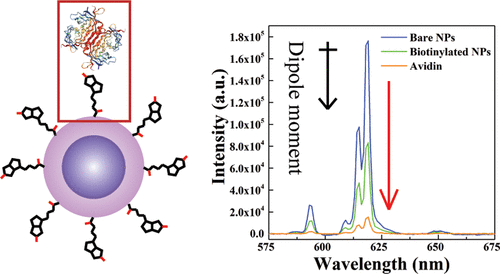Our official English website, www.x-mol.net, welcomes your
feedback! (Note: you will need to create a separate account there.)
Dipole-Modulated Downconversion Nanoparticles as Label-Free Biological Sensors.
ACS Sensors ( IF 8.2 ) Pub Date : 2020-01-10 , DOI: 10.1021/acssensors.9b02204 Khashayar R Bajgiran 1 , James A Dorman 1 , Adam T Melvin 1
ACS Sensors ( IF 8.2 ) Pub Date : 2020-01-10 , DOI: 10.1021/acssensors.9b02204 Khashayar R Bajgiran 1 , James A Dorman 1 , Adam T Melvin 1
Affiliation

|
Ultrasensitive detection of proteins and biomolecules has been previously achieved by optical nanoparticles (NPs) using the principles of Förster resonance energy transfer (FRET). However, the inherent need for labeling the target analyte in these assays hinders their applicability in point-of-use (POU) diagnostics. In this work, a label-free NP-based sensor has been developed that utilizes downconversion luminescence and surface electric dipoles as a novel approach for the detection of avidin. The long-lived luminescence of Eu3+-doped biotinylated NPs was effectively quenched in the presence of avidin in a concentration-dependent manner. The NPs exhibited high avidin selectivity and sensitivity with a limit of detection (LOD) of 7.8 nM and a wide dynamic range spanning 1 nM to 10 μM in deionized (DI) water. The application of the assay in a complex biological matrix consisting of cell growth medium supplemented with 10% v/v serum was verified with minor effects on avidin sensitivity exhibited by an LOD of 34.7 nM. The performance of the system was evaluated by comparing the photoluminescence (PL) intensities of known avidin concentration and the values predicted by the generated calibration curve. The new biosensing strategy has the potential to be extended to the detection of other disease biomarkers or pathogens with LOD and limited matrix effects in POU settings.
中文翻译:

偶极调制的降频转换纳米粒子作为无标记生物传感器。
先前已经使用Förster共振能量转移(FRET)的原理通过光学纳米颗粒(NP)实现了蛋白质和生物分子的超灵敏检测。但是,在这些分析中标记目标分析物的固有需求阻碍了它们在使用点(POU)诊断中的适用性。在这项工作中,已经开发了一种无标记的基于NP的传感器,该传感器利用下转换发光和表面电偶极子作为检测亲和素的新方法。Eu3 +掺杂的生物素化NPs的长寿命发光在抗生物素蛋白存在下以浓度依赖的方式有效地淬灭。NP在去离子(DI)水中表现出高的亲和素选择性和灵敏度,检测极限(LOD)为7.8 nM,动态范围宽至1 nM至10μM。验证了该测定法在由添加了10%v / v血清的细胞生长培养基组成的复杂生物基质中的应用,对34.7 nM的LOD表现出的亲和素敏感性影响较小。通过比较已知抗生物素蛋白浓度的光致发光(PL)强度与生成的校准曲线预测的值来评估系统的性能。新的生物传感策略可能会扩展到检测具有LOD和在POU设置中具有有限基质效应的其他疾病生物标记或病原体。通过比较已知抗生物素蛋白浓度的光致发光(PL)强度与生成的校准曲线预测的值来评估系统的性能。新的生物传感策略可能会扩展到检测具有LOD和在POU设置中具有有限基质效应的其他疾病生物标记或病原体。通过比较已知抗生物素蛋白浓度的光致发光(PL)强度与生成的校准曲线预测的值来评估系统的性能。新的生物传感策略可能会扩展到检测具有LOD和在POU设置中具有有限基质效应的其他疾病生物标记或病原体。
更新日期:2020-01-10
中文翻译:

偶极调制的降频转换纳米粒子作为无标记生物传感器。
先前已经使用Förster共振能量转移(FRET)的原理通过光学纳米颗粒(NP)实现了蛋白质和生物分子的超灵敏检测。但是,在这些分析中标记目标分析物的固有需求阻碍了它们在使用点(POU)诊断中的适用性。在这项工作中,已经开发了一种无标记的基于NP的传感器,该传感器利用下转换发光和表面电偶极子作为检测亲和素的新方法。Eu3 +掺杂的生物素化NPs的长寿命发光在抗生物素蛋白存在下以浓度依赖的方式有效地淬灭。NP在去离子(DI)水中表现出高的亲和素选择性和灵敏度,检测极限(LOD)为7.8 nM,动态范围宽至1 nM至10μM。验证了该测定法在由添加了10%v / v血清的细胞生长培养基组成的复杂生物基质中的应用,对34.7 nM的LOD表现出的亲和素敏感性影响较小。通过比较已知抗生物素蛋白浓度的光致发光(PL)强度与生成的校准曲线预测的值来评估系统的性能。新的生物传感策略可能会扩展到检测具有LOD和在POU设置中具有有限基质效应的其他疾病生物标记或病原体。通过比较已知抗生物素蛋白浓度的光致发光(PL)强度与生成的校准曲线预测的值来评估系统的性能。新的生物传感策略可能会扩展到检测具有LOD和在POU设置中具有有限基质效应的其他疾病生物标记或病原体。通过比较已知抗生物素蛋白浓度的光致发光(PL)强度与生成的校准曲线预测的值来评估系统的性能。新的生物传感策略可能会扩展到检测具有LOD和在POU设置中具有有限基质效应的其他疾病生物标记或病原体。











































 京公网安备 11010802027423号
京公网安备 11010802027423号